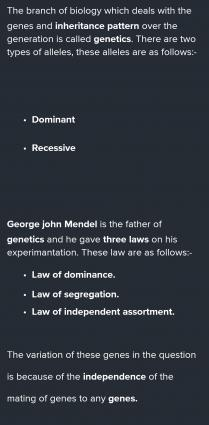 57
57 D
Explanation:
Phenotypes are your physical traits and they can be altered by the environment. Your genotype is your genes and genetic code. This cannot be altered and is the instructions for making proteins.
 57
57 D
Explanation:
Phenotypes are your physical traits and they can be altered by the environment. Your genotype is your genes and genetic code. This cannot be altered and is the instructions for making proteins.

Therefore, the variation of these genes and characters is because of these variations.
 6
6 Step-by-step explanation:
A. In the equation, the n represents the no. of genes involved. If n =1, a single gene is responsible, then X= (1/4)^1= 1/4 offsprings will be of one parental type.
B. Out of 50,000 plants, 1 out of 500 had maize phenotype and another 1 out of 500 terosinte phenotype.
So 1 in 500 so how much in 50000?
1*50000/500 = 100.
100 plants are of terosinte and 100 are of maize phenotype. The rest plants have recombinant phenotype. The exact phenotypes cannot be told from the given information.
C. According to formula, if 2 genes are involved, then 1 in 16 will be of one parental type. If genes 4 are involved, then 1 in 4^4= 1 in 256 will be of one parental type. If 5 genes are involved then it will be 1 in 512 plants will be of parental type. On the question, every 1 in 500 plants have one parental type. Hence Dr.Beadle concluded that 4 or 5 genes are involved in the phenotypic difference.
D. Genes code for all physical characteristics of an organism. Changes to genetic material can result in far reaching consequences in one or more particular metabolic pathways, this results in different phenotype compared to parents. Genes can mask other genes effect, complement it, or supplement it resulting in diverse response. The genes can also act in additive manner called quantitative genetics. Certain gene upon expression can block other genes expression, called epistasis. Such diverse mechanism can result in very different looking plants even with changes in small number of genes.
See the answer below.
Explanation:
Fertilization contributes to genetic variability through random fusion of male and female gametes.
Gametes are generated during the process of meiotic cell division. Male gametes are generated through spermatogenesis while female gametes are generated through oogenesis.
The male gamete contains haploid paternal chromosome while the female gamete contains haploid maternal chromosome.
During fertilization, each parent is able to contribute a unique set of the haploid chromosome to form a diploid zygote. This process of gene shuffling and random fusion results in more genetically variable offspring.
 6
6 Step-by-step explanation:
A. In the equation, the n represents the no. of genes involved. If n =1, a single gene is responsible, then X= (1/4)^1= 1/4 offsprings will be of one parental type.
B. Out of 50,000 plants, 1 out of 500 had maize phenotype and another 1 out of 500 terosinte phenotype.
So 1 in 500 so how much in 50000?
1*50000/500 = 100.
100 plants are of terosinte and 100 are of maize phenotype. The rest plants have recombinant phenotype. The exact phenotypes cannot be told from the given information.
C. According to formula, if 2 genes are involved, then 1 in 16 will be of one parental type. If genes 4 are involved, then 1 in 4^4= 1 in 256 will be of one parental type. If 5 genes are involved then it will be 1 in 512 plants will be of parental type. On the question, every 1 in 500 plants have one parental type. Hence Dr.Beadle concluded that 4 or 5 genes are involved in the phenotypic difference.
D. Genes code for all physical characteristics of an organism. Changes to genetic material can result in far reaching consequences in one or more particular metabolic pathways, this results in different phenotype compared to parents. Genes can mask other genes effect, complement it, or supplement it resulting in diverse response. The genes can also act in additive manner called quantitative genetics. Certain gene upon expression can block other genes expression, called epistasis. Such diverse mechanism can result in very different looking plants even with changes in small number of genes.
See the answer below.
Explanation:
Fertilization contributes to genetic variability through random fusion of male and female gametes.
Gametes are generated during the process of meiotic cell division. Male gametes are generated through spermatogenesis while female gametes are generated through oogenesis.
The male gamete contains haploid paternal chromosome while the female gamete contains haploid maternal chromosome.
During fertilization, each parent is able to contribute a unique set of the haploid chromosome to form a diploid zygote. This process of gene shuffling and random fusion results in more genetically variable offspring.
option B:is correct answer
may be this helpful!

It will provide an instant answer!
